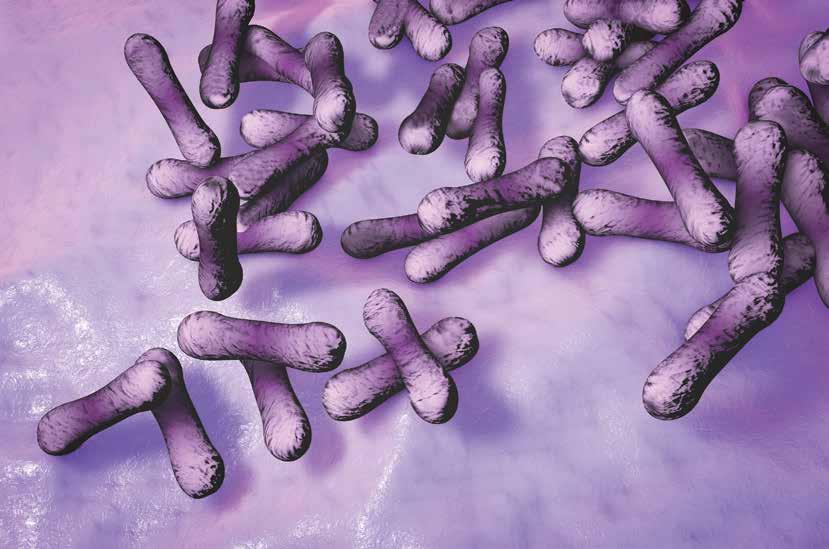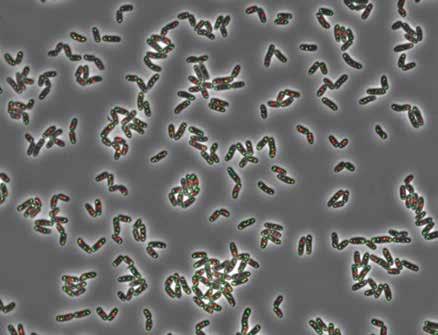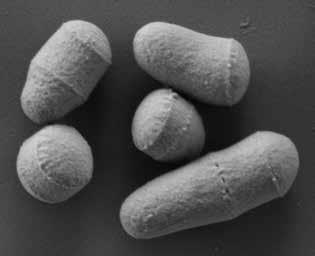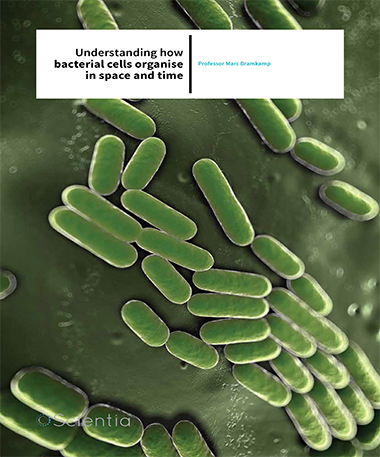Professor Marc Bramkamp – Understanding How Bacterial Cells Organise In Space And Time
Professor Marc Bramkamp of the Ludwig-Maximilians University in Munich, Germany, is at the forefront of research into the growth, division and chromosome organisation of bacterial microorganisms. He uses state-ofthe art techniques, such as live cell imaging, protein-protein and protein-DNA interaction studies, and in vitro reconstitution to unveil their secrets.

Bacteria: curious cells
Bacteria are single celled prokaryotic microorganisms. Bacterial cells exhibit a wide range of shapes and differ in many ways to eukaryotic cells, such as those that make up the human body. Their cellular organisation, which is markedly different to ours, is one of the key focuses of Professor Marc Bramkamp and his team at the Ludwig- Maximilians University in Munich, Germany. He tells us about what drew him to the field of bacterial cell biology research: ‘Bacteria were, for a long time, not considered to be interesting targets for cell biological research because their level of complexity seemed much lower than that of eukaryotic cells. They lack a sophisticated endomembrane system, have no organelles (with very few, but exciting exceptions, such as magnetosomes), and were actually not ideal models for imaging techniques because of their small size.’ he explains. ‘Our knowledge of subcellular organisation of bacterial cells was revolutionised in the early 2000s with the discovery that some bacterial cells contain an extended cytoskeleton, reminiscent to the eukaryotic actin cytoskeleton.’ After completing his PhD in 2003, Professor Bramkamp wanted to be a part of this new field of bacterial cell biology.
Marvellous Membranes
As Professor Bramkamp was particularly interested in bacterial cell organisation, this became the major focus of his work. ‘Our work aims to understand how bacterial cells organise proteins in space and time. We focus largely on the organisation of the plasma membrane. This is the lipid membrane that surrounds the entire bacterial cell and defines the boundary between the inside and outside of the cell. Every molecule that needs to enter or leave the cell must pass through the membrane and hence, many transport systems are localised in the membrane to ensure correct exchange.’ he explains. ‘Furthermore, the cell needs to sense its environment and most of its sensors are integrated into the membrane’.
It has long been thought that these membrane embedded proteins are able to freely diffuse within the lipid building blocks of bacterial membranes. In their research, Professor Bramkamp and his team have shown that the membrane is highly organised and complex. They have also discovered that proteins are often clustered in defined domains. These domains are organised by flotillins, scaffolding proteins, previously known only from eukaryotic cells. Flotillins seem to recruit cargo proteins into defined membrane regions in which they function.
Wondrous Walls
The team have also extensively investigated bacterial cell walls and have found that the proteins and enzyme complexes that synthesise bacterial cell walls are also highly organised. He gives a brief description of their structure and function: ‘Most bacteria contain a cell wall made of sugar polymers that are crosslinked by peptide-bridges, called peptidoglycan. The cell wall acts as an exoskeleton and defines the shape of a cell and allows the cell to survive osmotic changes in the environment. Since the peptidoglycan cell wall is unique to bacteria, the enzymes making the cell wall are ideal targets for antibiotics, such as penicillin. The localisation of the cell wall synthetic complexes defines how a cell is shaped. Most rod-shaped bacteria such as Escherichia coli insert the new cell wall material at their lateral sites.’
Such rod-shaped model organisms, which include Escherichia coli and Bacillus subtilis, have been used and studied extensively by a number of bacterial cell biologists, including Professor Bramkamp. A fundamental question that all cells need to deal with is the correct positioning of the cell division apparatus of which FtsZ, a bacterial tubulin, is the central structural element. Many bacteria, including B. subtilis and E. coli employ the so-called Min system for spatial regulation of FtsZ assembly. The Min system is composed of an FtsZ polymerisation inhibitor, MinC, a Walker-type ATPase, MinD, and a spatial regulator. In 2008, he found a new member of the Min system that acts as a bridge to hook up MinCD to the sites of division. Against previous predictions, the group found that Min proteins are highly dynamic in B. subtilis and actively prevent re-initiation of cell division in vicinity to used division sites. However, Min proteins are not present in all bacteria, such as those that grow from their tips (cell poles). He and his team have therefore developed the Corynebacterium glutamicum model, that lacks the known Min system for cell division, to further investigate this. As he explains: ‘Some species, such as the notorious pathogen Mycobacterium tuberculosis, grow from their cell poles and we know little about the organisation of this cell elongation machinery. We have developed a close relative to M. tuberculosis, the non-pathogenic bacterium C. glutamicum, into a model organism to study polar cell elongation, cell division and chromosome segregation.’ The team hope that by gaining greater insight into the interactions and enzymatic properties of the proteins involved, they might be able to define new antibiotic targets.
Creating Corynebacterium glutamicum into a cell biological model organism
The subcellular organisation of C. glutamicum is significantly different to that of all previous model bacteria. In addition to lacking the Min division site selection systems, it elongates by polar peptidoglycan insertion and lacks an actin-like cytoskeleton. The Bramkamp group identified that chromosome segregation depends on a ParABS system (which is similar to C. crescentus). Its chromosome organisation also seems to be different to other model organisms; B. subtilis and C. crescentus encode SMC proteins, while E. coli utilises a homologous system, named MukBEF. In their preliminary studies, Professor Bramkamp and his team found that C. glutamicum actually encodes both of these systems. He adds: ‘We have been the first to describe the molecular machinery that positions and segregates the chromosome in C. glutamicum and how this impacts on growth and division. We now want to take these initial descriptions to the next level and address the exact chromosomal organisation in C. glutamicum.’
‘Our knowledge of subcellular organisation of bacterial cells was revolutionised in the early 2000s with the discovery that some bacterial cells contain an extended cytoskeleton, reminiscent to the eukaryotic actin cytoskeleton’

Chromosomal Uncovering
To produce viable offspring, bacterial cytokinesis must be regulated both spatially and temporally. This cell division is connected to other processes such as chromosome domain organisation, chromosome compaction and chromosome segregation. Professor Bramkamp plans to determine how these processes occur in C. glutamicum.
The analysis of chromosome organisation will be done in a few different steps. First, the team will use operator arrays to visualise chromosomal loci, then they will map the gene loci using chromosome conformation capture (3C/3C-seq) assays. Finally, they will localise and characterise the nucleoid associated proteins (mainly SMC/MksB).
Chromosomal compaction is an important process involved in the creation of a bacterial nucleoid. This is a submicron sized compartment in which the chromosome is highly compacted (approximately 1000 times), which has some loops of DNA that extend like bristles. C. crescentus has one circular chromosome, and the threedimensional structure of the C. crescentus genome has recently been described as ellipsoidal with entangled arms.
Chromosome segregation is mediated by the ParA-ATPase complex, which Professor Bramkamp postulates could use the nucleoid spatial track. This is due to previous findings that have suggested that ParA proteins use the nucleoid as a template to gain positional information and as such, the structure of the chromatin also provides informational cues for segregation. He plans to address this theory in three ways using new experimental tools that have been developed in his lab: time lapse deconvolution microscopy, interference with chromosome organisation to proof the hypothesis of a nucleoid-track, and molecular and cellular analysis of Par protein mutants.
Professor Bramkamps breakthroughs in C. glutamicum cell biology
Thus far, Professor Bramkamp’s lab has extensively investigated chromosome segregation in C. glutamicum, and in doing so has made some key discoveries. By introducing tetO arrays into an intergenic region at the oriC, the team has demonstrated that the oriC is located to the cell poles. They have also shown that the conventional ParB protein identifies consensus parS sites at the origin region and co-localises with the oriC to the cell poles. When replication is initiated, the newly formed origin migrates to the cell centre, were the cell is about to divide. By this, the segregated origin is placed close to the new developing pole. This process requires ParA, which localises across the nucleoid, with its focal point close to the cell poles, likely co-localising with ParB.
However, as of yet, they have been unable to determine the nature of ParA assembly through light microscopy. Professor Bramkamp postulates that ParA shows DNA-binding and ATPase activity in vitro, and the positioning of ParA proteins over the nucleoid may hint that the partitioning ATPase uses spatial information of the nucleoid for correct movement of the ParB-parS nucleoprotein complex. He continues to work towards identifying the molecular mechanism of the polar anchoring of the chromosome. And recently, he has identified that the C. glutamicum homologue of DivIVA is a landmark protein that interacts directly with an N-terminal motif in ParB and thereby tethers the ParBparS complex to the cell poles.
In the same study, he and his team showed that other actinobacteria, such as M. tuberculosis, undergo a similar mechanism – DivIVA interacts with corresponding ParB proteins. In a follow up study, the interaction domains of ParB and DivIVA were mapped. However, Professor Bramkamp notes that, at present, it is not clear how the newly replicated origin with bound ParB escapes polar anchoring. Additional findings have led to the assumption that positional information of the nucleoid is a main regulator of division site selection, in accordance with the variable cell length of daughter cells in C. glutamicum. The team has also revealed the chromosome organisation in a number of processes related to cell growth and cytokinesis, through the use of microfluidic devices and time lapse analysis.
In his recent work, Professor Bramkamp and his team identified together with colleagues from Juelich around Professor Frunzke that the genome of C. glutamicum encodes for an actin-like protein. Corynebacteria are normally known for the absence of such a cytoskeleton, but close inspection revealed that this actin-like protein, termed AlpC, is encoded in a prophage region. Prophages are bacterial viruses that integrate into the host genome and replicate with the host DNA. Only under stress conditions, the phage ‘revives’ and multiplies its DNA. The two groups showed that AlpC builds a phage specific DNA segregation machinery in which AlpC connects to the viral DNA via an adapter protein, AlpA. AlpA recognises a DNA repeat within the phage DNA. The two research teams could show that viral DNA segregation is vital for correct DNA replication. These findings reveal that the relation between actin and viral DNA is evolutionary ancient and conserved from bacteria to humans.


Trying New Technologies
In the future, Professor Bramkamp and his team will be using new techniques to develop their studies of bacterial cell organisation. He notes that ‘new microscopy methods are now available that allow single molecule detection. These techniques rely on the stochastic switching of fluorophores in a way that every fluorophore in a cell can be imaged separately and its precise position is than calculated individually.’ This technique is called photoactivated localisation microscopy (PALM). Professor Bramkamp concludes: ‘With PALM, we can address subcellular structures with unprecedented precision and can identify objects of about 20 nm – 10 times greater than previous resolution. This allows us to gain insights into the organisation of Corynebacterium cells. We are especially interested in understanding how the polar cell wall synthesis is coupled to chromosome organisation.’
Meet the researcher

Professor Marc Bramkamp
Professor of Microbiology
Ludwig-Maximilians-Universität
Munich, Germany
Marc Bramkamp is Professor of Microbiology at the Ludwig- Maximilians-Universität, in Munich, Germany. He received his undergraduate degree in Biological Science at the University of Osnabrück in Germany and went on to complete his PhD at the same university in 2003. He worked under the supervision of Professor K. Altendorf throughout his PhD and subsequent postdoctoral studies until 2004 when he then moved to the Sir William Dunn School of Pathology at Oxford University in the UK for a further two years as a research fellow to work with Professor Jeff Errington. Prior to receiving his professorship in Munich in 2012, he worked at the University of Cologne in Germany (with Professor Reinhard Krämer) and was group leader of the Bacterial Cell Biology Lab.
CONTACT
E: marc.bramkamp@lmu.de
T: (+49) 89 2180 74611
W:http://www.bacteriology.bio.lmu.de/
FUNDING
DFG – Deutsche Forschungsgemeinschaft
BMBF (Bundesministerium für Bildung und Forschung
REFERENCES
Sawant P, Eissenberger K, Karier L, Mascher T, Bramkamp M, A dynaminlike protein involved in bacterial cell membrane surveillance under environmental stress, Environ Microbiol., 2016, 8, 2705–2720. doi: 10.1111/1462-2920.13110.
Donovan C, Heyer A, Pfeifer E, Polen T, Wittmann A, Krämer R, Frunzke J, Bramkamp M, A prophage-encoded actin-like protein required for efficient viral DNA replication in bacteria, Nucleic Acids Res., 2015, 43, 5002–5016. doi: 10.1093/nar/gkv374
Bramkamp M and Lopez D, Exploring the existence of lipid rafts in bacteria, Microbiol Mol Biol Rev., 2015, 79, 81–100. doi: 10.1128/ MMBR.00036-14.
Donovan C, Sieger B, Krämer R, Bramkamp, M, A synthetic Escherichia coli system identifies a conserved origin tethering factor in Actinobacteria, Mol Microbiol, 2012, 84, 105–116.


